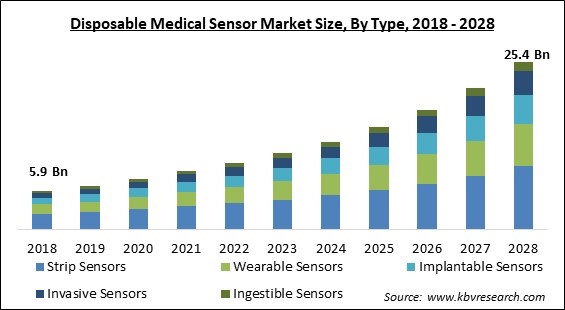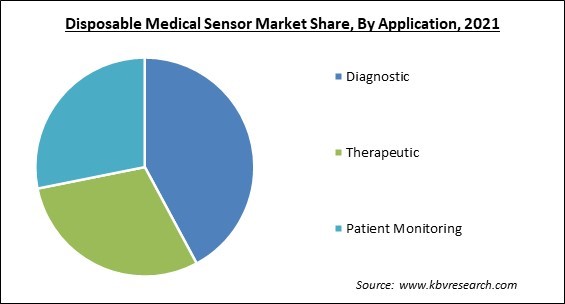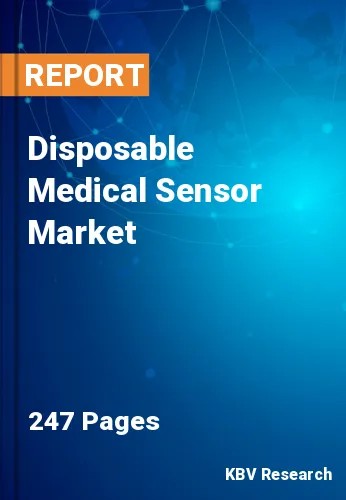The Global Disposable Medical Sensor Market size is expected to reach $25.4 billion by 2028, rising at a market growth of 16.8% CAGR during the forecast period.
Disposable medical sensors are easy-to-use and economical. Medical sensors, under which disposable medical sensors fall, are devices that aid in the detection of physical, biological, and chemical signals. These devices offer a way for these signals to be recorded and measured. The concentrations of substances in liquid, solid or gaseous forms along with the amplitude of electronic and magnetic fields are measured by these sensors.

The application of medical sensors has increased with the advancements in molecular chemistry and microchip technologies. Medical sensors are small preprogrammed technologies that are developed to analyze or detect changes and gather, advise, and alert in threatening situations. Most disposable medical sensors and portable devices can be extensively used in the diagnosis and monitoring of biological vitals.
Since these are highly versatile, they are vastly used in the fields of cardiology, cancer, neurology, radiography, proctology, and ophthalmology. They are also being used in many in-vitro clinical studies. The disposable medical sensors are used in assessing heart rate, blood pressure, pulse rate, cholesterol levels, oxygen levels, body temperature, and glucose levels.
The disposable medical sensor's flexibility or capacity to adapt to the human body is one of its important features. This is crucial for the matting electronics package's proper data reporting as well as for strong adherence. Medical sensors typically consist of a circuit, a patient attachment layer, and electronics, though they can be formed up of many different parts.
The skin of a patient must be directly adhered to for the disposable medical sensors to work correctly. This connection creates a mechanical and, in certain cases, an electrical relationship. The circuit serves as a conduit between the user and the electronics and is comprised of a thin, flexible layer of polyester or polyimide. The electronics incorporate unique systems for identifying, observing, and evaluating numerous human conditions.
During the pandemic, the gaps in the provision and offering of medical infrastructure were highlighted all across the world. The diversion of existing healthcare facilities towards the emergency cases of COVID-19 further displayed the lack of solutions and technology. This prevented the management of patients suffering from other diseases and disorders. Many manufacturers then proceeded to furbish the technological gaps in the healthcare infrastructure. This increased the development of portable and self-employable medical devices, which increased the number of patients taking up treatments in home care settings.
Nosocomially acquired illnesses that are not existing or hatching at the moment of admission to a hospital are known as hospital-acquired infections (HAIs). These infections may include bloodstream infections that are joined to central lines, urinary tract infections caused by the use of catheters, many surgical site infections, ventilators-influenced pneumonia, pneumonia acquired in hospitals, and infections with CD. Many different intrusive techniques and equipment are used in modern healthcare to cure patients and aid in their recovery.
Obesity and CVD are two lifestyle illnesses that are on the rise globally. The occurrence of obesity has significantly increased worldwide. Except for some areas of sub-Saharan Africa and Asia, there are more obese people than underweight people in every region of the world. According to studies, during the past ten years, the prevalence of CVD has nearly tripled in China and India. As the leading cause of death, cardiovascular diseases (CVD) continue to account for around 30% of all fatalities worldwide.
A capsule or pill remaining in the digestive tract for longer than two weeks is known as capsule retention or CR. Many patients with CR undergo small bowel capsule endoscopy. Due to its clinical relevance, CR must be identified right away. In addition to individuals with obstructive or perforation-related symptoms who have not yet excreted the capsule CR can be asserted in all asymptomatic patients who are unable to do so within 15 days following capsule ingestion. A straightforward abdomen X-ray is advised for verifying CR. To identify the illness, a CT scan of the abdomen must be performed.
Based on application, the disposable medical sensor market is categorized into diagnostic, therapeutic, and patient monitoring. The therapeutic segment witnessed a considerable growth rate in the disposable medical sensor market in 2021. Sensors used in equipment like ventilators, blood analyzers, sleep apnea machines, and neonatal intensive care units help in rehabilitation and facilitate the treatment of patients. Sensors built for rehabilitation are usually embedded in the equipment design and most of them do not display any information.

On the basis of product, the disposable medical sensor market is divided into biosensors, pressure sensors, accelerometers, temperature sensors, image sensors, and others. The biosensors segment garnered the largest revenue share in the disposable medical sensor market in 2021. These sensors collect biological data by using physiochemical detectors to detect the analyte. These sensors are usually found in medical devices, in which the collected data is shown on the screen of the device. Additionally, biosensors are adaptable to be used as monitoring or diagnostic sensor.
Based on type, the disposable medical sensor market is classified into strip sensors, wearable sensors, implantable sensors, invasive sensors, and ingestible sensors. The strip sensors segment recorded the maximum revenue share in the disposable medical sensor market in 2021. These sensors are used in disease testing, magnetic nanoparticles, and blood glucose monitoring. Additionally, these are expansively used in diagnostic applications and devices. Their wide use is attributed to the fast result development.
| Report Attribute | Details |
|---|---|
| Market size value in 2021 | USD 8.9 Billion |
| Market size forecast in 2028 | USD 25.4 Billion |
| Base Year | 2021 |
| Historical Period | 2018 to 2020 |
| Forecast Period | 2022 to 2028 |
| Revenue Growth Rate | CAGR of 16.8% from 2022 to 2028 |
| Number of Pages | 247 |
| Number of Tables | 400 |
| Report coverage | Market Trends, Revenue Estimation and Forecast, Segmentation Analysis, Regional and Country Breakdown, Companies Strategic Developments, Company Profiling |
| Segments covered | Type, Application, Product, Region |
| Country scope | US, Canada, Mexico, Germany, UK, France, Russia, Spain, Italy, China, Japan, India, South Korea, Singapore, Malaysia, Brazil, Argentina, UAE, Saudi Arabia, South Africa, Nigeria |
| Growth Drivers |
|
| Restraints |
|
On the basis of region, the disposable medical sensor market is analyzed across North America, Europe, Asia Pacific, and LAMEA. The North America segment acquired the highest revenue share in the disposable medical sensor market in 2021. Factors like well-established healthcare infrastructure, the presence of significant manufacturers, rapid adoption of innovations, and high spending on healthcare are propelling the growth of the segment. Additionally, the governments in the region have established beneficial reimbursement policies through national healthcare policies or health insurance.
Free Valuable Insights: Global Disposable Medical Sensor Market size to reach USD 25.4 Billion by 2028
The market research report covers the analysis of key stake holders of the market. Key companies profiled in the report include Medtronic PLC, Honeywell International, Inc., Analog Devices, Inc., ICU Medical, Inc. (Smiths Medical), Koninklijke Philips N.V., General Electric (GE) Co. (GE Healthcare), TE Connectivity Ltd., NXP Semiconductors N.V., Sensirion AG, and ACE Medical Devices Pvt. Ltd.
By Type
By Application
By Product
By Geography
The global Disposable Medical Sensor Market size is expected to reach $25.4 billion by 2028.
Increasing Incidences Of Hospital-Acquired Infections are driving the market in coming years, however, High Risk Of Capsule Retention In The Consumer's Body restraints the growth of the market.
Medtronic PLC, Honeywell International, Inc., Analog Devices, Inc., ICU Medical, Inc. (Smiths Medical), Koninklijke Philips N.V., General Electric (GE) Co. (GE Healthcare), TE Connectivity Ltd., NXP Semiconductors N.V., Sensirion AG, and ACE Medical Devices Pvt. Ltd.
The expected CAGR of the Disposable Medical Sensor Market is 16.8% from 2022 to 2028.
The Diagnostic segment is leading the Global Disposable Medical Sensor Market by Application in 2021 thereby, achieving a market value of $10.3 billion by 2028.
The North America market dominated the Global Disposable Medical Sensor Market by Region in 2021; thereby, achieving a market value of $10.1 billion by 2028.
Our team of dedicated experts can provide you with attractive expansion opportunities for your business.

